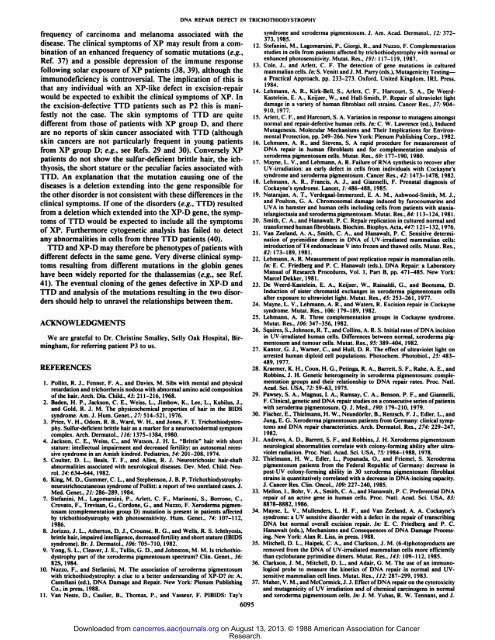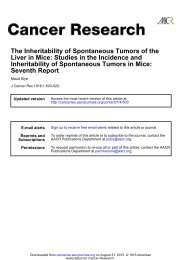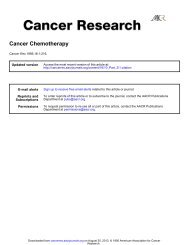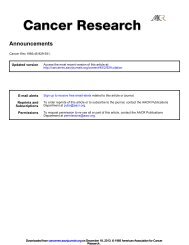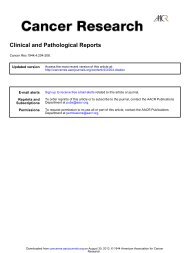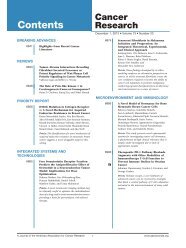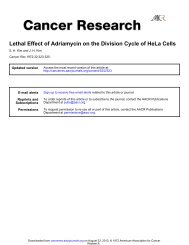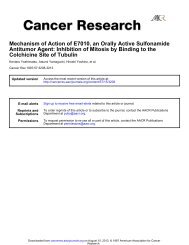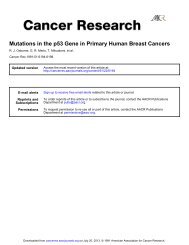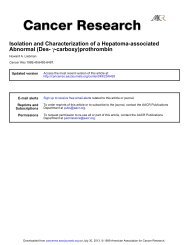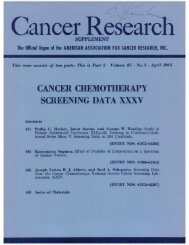Trichothiodystrophy, a Human DNA Repair ... - Cancer Research
Trichothiodystrophy, a Human DNA Repair ... - Cancer Research
Trichothiodystrophy, a Human DNA Repair ... - Cancer Research
You also want an ePaper? Increase the reach of your titles
YUMPU automatically turns print PDFs into web optimized ePapers that Google loves.
frequency of carcinoma and melanoma associated with the<br />
disease. The clinical symptoms of XP may result from a com<br />
bination of an enhanced frequency of somatic mutations (e.g..<br />
Ref. 37) and a possible depression of the immune response<br />
following solar exposure of XP patients (38, 39), although the<br />
immunodeficiency is controversial. The implication of this is<br />
that any individual with an XP-like defect in excision-repair<br />
would be expected to exhibit the clinical symptoms of XP. In<br />
the excision-defective TTD patients such as P2 this is mani<br />
festly not the case. The skin symptoms of TTD are quite<br />
different from those of patients with XP group D, and there<br />
are no reports of skin cancer associated with TTD (although<br />
skin cancers are not particularly frequent in young patients<br />
from XP group D; e.g., see Refs. 29 and 30). Conversely XP<br />
patients do not show the sulfur-deficient brittle hair, the ichthyosis,<br />
the short stature or the peculiar facies associated with<br />
TTD. An explanation that the mutation causing one of the<br />
diseases is a deletion extending into the gene responsible for<br />
the other disorder is not consistent with these differences in the<br />
clinical symptoms. If one of the disorders (e.g., TTD) resulted<br />
from a deletion which extended into the XP-D gene, the symp<br />
toms of TTD would be expected to include all the symptoms<br />
of XP. Furthermore cytogenetic analysis has failed to detect<br />
any abnormalities in cells from three TTD patients (40).<br />
TTD and XP-D may therefore be phenotypes of patients with<br />
different defects in the same gene. Very diverse clinical symp<br />
toms resulting from different mutations in the globin genes<br />
have been widely reported for the thalassemias (e.g., see Ref.<br />
41). The eventual cloning of the genes defective in XP-D and<br />
TTD and analysis of the mutations resulting in the two disor<br />
ders should help to unravel the relationships between them.<br />
ACKNOWLEDGMENTS<br />
We are grateful to Dr. Christine Smalley, Selly Oak Hospital, Bir<br />
mingham, for referring patient P3 to us.<br />
REFERENCES<br />
1. Pollitt, R. J., Fenner, F. A., and Davies. M. Sibs with mental and physical<br />
retardation and trichorrhexis nodosa with abnormal amino acid composition<br />
of the hair. Arch. Dis. Child., 43: 211-216. 1968.<br />
2. Baden. H. P., Jackson. C. E.. Weiss. L.. Jimbow. K.. Lee. L.. Kubilus. J..<br />
and Gold, R. J. M. The physicochemical properties of hair in the BIDS<br />
syndrome. Am. J. Hum. Genet., 27: 514-521, 1976.<br />
3. Price, V. H.. Odom. R. B.. Ward, W. H., and Jones. F. T. <strong>Trichothiodystrophy</strong>.<br />
Sulfur-deficient brittle hair as a marker for a neuroectodermal symptom<br />
complex. Arch. Dermatol., 116: 1375-1384, 1980.<br />
4. Jackson. C. E., Weiss, C., and Watson, J. H. L. "Brittle" hair with short<br />
stature: intellectual impairment and decreased fertility: an autosomal reces<br />
sive syndrome in an Amish kindred. Pediatrics. 54: 201-208, 1974.<br />
5. Coulter, D. L.. Beals. T. F.. and Allen. R. J. Neurotrichosis: hair-shaft<br />
abnormalities associated with neurological diseases. Dev. Med. Child. Neurol.<br />
24:634-644. 1982.<br />
6. King. M. D., Gummer, C. L.. and Stephenson, J. B. P. <strong>Trichothiodystrophy</strong>neurotrichocutaneous<br />
syndrome of Pollitt: a report of tuo unrelated cases. J.<br />
Med. Genet.. 21: 286-289. 1984.<br />
7. Stefanini. M., Lagomarsini. P., Arieti, C. F., Marinoni. S., Burrone, C.,<br />
Crovato, F., Trevisan. G., Cordone. G.. and Nuzzo, F. Xeroderma pigmentosum<br />
(complementation group D) mutation is present in patients affected<br />
by trichothiodystrophy with photosensitivity. Hum. Genet.. 74: 107-112.<br />
1986.<br />
8. Jorizzo, J. L., Atherton. D. J., Crounse. R. G.. and Wells. R. S. Ichthyosis.<br />
brittle hair, impaired intelligence, decreased fertility and short stature (IBIDS<br />
syndrome). Br. J. Dermatol., 106: 705-710. 1982.<br />
9. Yong, S. L., Cleaver, J. E., TullÃs,G. D., and Johnston, M. M. Is trichothio<br />
dystrophy part of the xeroderma pigmentosum spectrum? Clin. Genet., 36:<br />
82S, 1984.<br />
10. Nuzzo, F.. and Stefanini, M. The association of xeroderma pigmentosum<br />
with trichothiodystrophy: a clue to a better understanding of XP-D? in: A.<br />
Castellani (ed.), <strong>DNA</strong> Damage and <strong>Repair</strong>. New York: Plenum Publishing<br />
Co.. in press. 1988.<br />
11. Van Neste, D.. Caulier. B.. Thomas. P.. and Vasseur. F. PIBIDS: Tay's<br />
<strong>DNA</strong> REPAIR DEFECT IN TRICHOTHIODYSTROPHY<br />
6095<br />
12<br />
13.<br />
14.<br />
15.<br />
16.<br />
17.<br />
18.<br />
19.<br />
20.<br />
21.<br />
22.<br />
23.<br />
24.<br />
25.<br />
26.<br />
27.<br />
28.<br />
29.<br />
30.<br />
31.<br />
32.<br />
33.<br />
34.<br />
35.<br />
36.<br />
37.<br />
syndrome and xeroderma pigmentosum. J. Am. Acad. Dermatol.. 12: 372-<br />
373. 1985.<br />
Stefanini. M.. Lagomarsini. P.. Giorgi, R.. and Nuzzo, F. Complementation<br />
studies in cells from patients affected by trichothiodystrophy with normal or<br />
enhanced photosensitivity. Mutât.Res.. 191: 117-119. 1987.<br />
Cole. J.. and Arieti. C. F. The detection of gene mutations in cultured<br />
mammalian cells./n:S. Venittand J. M. Parry (eds.). Mutagenicity Testing—<br />
a Practical Approach, pp. 233-273. Oxford. United Kingdom. IRL Press.<br />
1984.<br />
Lehmann. A. R.. Kirk-Bell, S., Arie».C. F., Harcourt, S. A., De Weerd-<br />
Kastelein, E. A., Keijzer, W., and Hall-Smith. P. <strong>Repair</strong> of ultraviolet light<br />
damage in a variety of human fibroblast cell strains. <strong>Cancer</strong> Res.. 37: 904-<br />
910. 1977.<br />
Arlett, C. F.. and Harcourt. S. A. Variation in response to mutagens amongst<br />
normal and repair-defective human cells. In: C. W. Lawrence (ed.). Induced<br />
Mutagencsis. Molecular Mechanisms and Their Implications for Environ<br />
mental Protection, pp. 249-266. New Y'ork: Plenum Publishing Corp.. 1982.<br />
Lehmann, A. R., and Stevens, S. A rapid procedure for measurement of<br />
<strong>DNA</strong> repair in human fibroblasts and for complementation analysis of<br />
xeroderma pigmentosum cells. Mutât.Res.. 69: 177-190. 1980.<br />
Mayne, L. V., and Lehmann. A. R. Failure of RNA synthesis to recover after<br />
UV-irradiation: an early defect in cells from individuals with Cockayne's<br />
syndrome and xeroderma pigmentosum. <strong>Cancer</strong> Res.. 42: 1473-1478. 1982.<br />
Lehmann. A. R.. Francis, A. J.. and Giannelli. F. Prenatal diagnosis of<br />
Cockayne's syndrome. Lancet, /: 486-488. 1985.<br />
Natarajan. A. T., Verdegaal-Immerzeel, E. A. M., Ashwood-Smith, M. J..<br />
and Poulton. G. A. Chromosomal damage induced by furocoumarins and<br />
UVA in hamster and human cells including cells from patients with ataxiatelangiectasia<br />
and xeroderma pigmentosum. Mutât.Res.. 84:113-124, 1981.<br />
Smith. C. A., and Hanawalt. P. C. <strong>Repair</strong> replication in cultured normal and<br />
transformed human fibroblasts. Biochim. Biophys. Acta. 447:121-132,1976.<br />
Van Zeeland, A. A., Smith, C. A., and Hanawalt, P. C. Sensitive determi<br />
nation of pyrimidine dimers in <strong>DNA</strong> of UV-irradiated mammalian cells:<br />
introduction of T4 endonuclease V into frozen and thawed cells. Mutât.Res..<br />
«2:173-189. 1981.<br />
Lehmann. A. R. Measurement of post replication repair in mammalian cells.<br />
In: E. C. Friedberg and P. C. Hanawalt (eds.). <strong>DNA</strong> <strong>Repair</strong>: a Laboratory<br />
Manual of <strong>Research</strong> Procedures, Vol. 1, Part B, pp. 471-485. New York:<br />
Marcel Dekker, 1981.<br />
De Weerd-Kastelein. E. A., Keijzer, W., Rainaldi, G., and Bootsma. D.<br />
Induction of sister chromatid exchanges in xeroderma pigmentosum cells<br />
after exposure to ultraviolet light. Mutât.Res., 45: 253-261, 1977.<br />
Mayne, L. V., Lehmann. A. R., and Waters, R. Excision repair in Cockayne<br />
syndrome. Mutât.Res.. 106: 179-189, 1982.<br />
Lehmann. A. R. Three complementation groups in Cockayne syndrome.<br />
Mutât.Res.. 706: 347-356, 1982.<br />
Squires. S., Johnson, R. T., and Collins, A. R. S. Initial rates of <strong>DNA</strong> incision<br />
in UV-irradiated human cells. Differences between normal, xeroderma pig<br />
mentosum and tumour cells. Mutât.Res.. 95: 389-404. 1982.<br />
Kantor. G. J., Warner, C., and Hull. D. R. The effect of ultraviolet light on<br />
arrested human diploid cell populations. Photochem. Photobiol., 25: 483-<br />
489. 1977.<br />
Kraemer. K. H.. Coon. H. G.. Petinga, R. A.. Barrett. S. F.. Rahe. A. E., and<br />
Robbins. J. H. Genetic heterogeneity in xeroderma pigmentosum: comple<br />
mentation groups and their relationship to <strong>DNA</strong> repair rates. Proc. Nati.<br />
Acad. Sci. USA, 72: 59-63, 1975.<br />
Pawsey, S. A., Magnus, I. A., Ramsay, C. A.. Benson. P. F., and Giannelli,<br />
F. Clinical, genetic and <strong>DNA</strong> repair studies on a consecutive series of patients<br />
with xeroderma pigmentosum. Q. J. Med., 190: 179-210, 1979.<br />
Fischer, E., Thielmann, H. W.. NeundÃrfer,B., Rentsch, F. J., Edler, L., and<br />
Jung, E. G. Xeroderma pigmentosum patients from Germany: clinical symp<br />
toms and <strong>DNA</strong> repair characteristics. Arch. Dermatol. Res., 274: 229-247,<br />
1982.<br />
Andrews, A. D.. Barrett. S. F., and Robbins, J. H. Xeroderma pigmentosum<br />
neurological abnormalities correlate with colony-forming ability after ultra<br />
violet radiation. Proc. Nati. Acad. Sci. USA, 75: 1984-1988, 1978.<br />
Thielmann, H. W., Edler, L., Popanada, O., and Friemel, S. Xeroderma<br />
pigmentosum patients from the Federal Republic of Germany: decrease in<br />
post-UV colony-forming ability in 30 xeroderma pigmentosum fibroblast<br />
strains is quantitatively correlated with a decrease in <strong>DNA</strong>-incising capacity.<br />
J. <strong>Cancer</strong> Res. Clin. Oncol.. 109: 227-240. 1985.<br />
Mellon, I., Bohr. V. A.. Smith, C. A., and Hanawalt. P. C. Preferential <strong>DNA</strong><br />
repair of an active gene in human cells. Proc. Nati. Acad. Sci. USA, 83:<br />
8878-8882, 1986.<br />
Mayne. L. V., Mullenders, L. H. F., and Van Zeeland. A. A. Cockayne's<br />
syndrome: a UV sensitive disorder with a defect in the repair of transcribing<br />
<strong>DNA</strong> but normal overall excision repair. In: E. C. Friedberg and P. C.<br />
Hanawalt (eds.). Mechanisms and Consequences of <strong>DNA</strong> Damage Process<br />
ing. New York: Alan R. Liss. in press. 1988.<br />
Mitchell. D. L., Haipek, C. A., and Clarkson, J. M. (6-4)photoproducts are<br />
removed from the <strong>DNA</strong> of UV-irradiated mammalian cells more efficiently<br />
than cyclobutane pyrimidine dimers. Mutât.Res.. 143: 109-112. 1985.<br />
Clarkson. J. M.. Mitchell. D. L., and Adair, G. M. The use of an immunological<br />
probe to measure the kinetics of <strong>DNA</strong> repair in normal and UVsensitive<br />
mammalian cell lines. Mutât.Res.. 112: 287-299, 1983.<br />
Mäher.V. M..and McCormick. J. J. Effect of <strong>DNA</strong> repair on the cytotoxicity<br />
and mutagenicity of UV irradiation and of chemical carcinogens in normal<br />
and xeroderma pigmentosum cells. In: J. M. Yuhas. R. W. Tennant. and J.<br />
Downloaded from<br />
cancerres.aacrjournals.org on August 13, 2013. © 1988 American Association for <strong>Cancer</strong><br />
<strong>Research</strong>.


